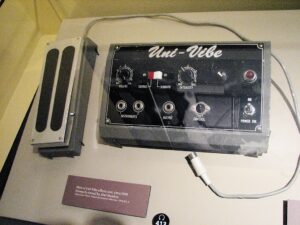I have always loved the tone of Uni-Vibe pedals. However, using a software-only solution for guitar tones (with Axiom and other plug-ins), even for live gigs, the use of a hardware pedal is not very convenient. Especially with the Uni-Vibe, which can be located in many different places the signal chain, depending on the tone you are looking for: before or after the amp, before or after distortion pedals etc.
That’s how the creation of PolyVibe started: Uni-vibe is one of the very few built-in effects that was missing in Axiom, which is already quite deep. But it actually ended up being a long journey, resulting in a plug-in that is not “just” an emulation of the Uni-Vibe!
Reproducing the “Uni-Vibe Tone”

Measuring and listening to several pedals, reading many papers on the topic, the algorithm for the “Uni-Vibe” tone was created, using a digital design that is similar to the original analog idea. It worked pretty well. But the problem with Univibes is that they all sound different, because of the variability of the components (and their age), and the sensitivity of the design to these differences (not all analog pedal vary that much).
Some more parameters were thus added, in order to control the capabilities of the filters: the center frequency around which the filters are moving, the bandwidth of each filter, their separation (how far apart they are located in the spectrum). And some more for the oscillator: the swing parameter controls the exact shape of the oscillator (because of the optical design of the Uni-Vibe, each unit is really unique).
This way you can precisely define and control the tone of the Uni-Vibe plug-in – no need to try out dozens of pedals to get the right one!
Adding Some More “More”
 But sometimes more is more, right? So instead of limiting the range of these controls to only mimic existing pedals, they have been increased up to a point where the tone becomes really different, and where completely new effects can be created. And it’s also a way to support other instruments than guitar (a bass guitar or a synth operate at very different frequencies). That was becoming interesting!
But sometimes more is more, right? So instead of limiting the range of these controls to only mimic existing pedals, they have been increased up to a point where the tone becomes really different, and where completely new effects can be created. And it’s also a way to support other instruments than guitar (a bass guitar or a synth operate at very different frequencies). That was becoming interesting!
Thinking about the filters, the next step consisted in adding several modes: the “classic” filter mode operates like a classic Univibe, but trying other types of filters for the fun of it (and keeping the same behavior otherwise) opened up a lot of creative possibilities. That’s how the “reversed” and “phase” mode appeared, the only survivors of many experiments.
 And since the digital world offers more freedom for the control of filters and oscillators, what about changing the way the filters move? In a Uni-Vibe they move in the same direction, in parallel. Changing the motion to opposite create some very interesting movements in the spectrum, especially when they start crossing each other.
And since the digital world offers more freedom for the control of filters and oscillators, what about changing the way the filters move? In a Uni-Vibe they move in the same direction, in parallel. Changing the motion to opposite create some very interesting movements in the spectrum, especially when they start crossing each other.
Finally, the stereo mode (which does not exist in pedals, as far as I know) was more “natural” to add, as all our other modulation plug-ins already have it. And of course, adding the option to synchronize the oscillator with the DAW was obvious too, if you want to keep the modulation in sync with the song.
And that’s how this vintage “Uni”-Vibe project ended up as a modern “Poly”-Vibe plug-in, with much more versatility than the original, but with still the same unique signature. But let’s see how it sounds!
Blue Cat’s PolyVibe Guitar Tones
Here are a few examples of the guitar tones that you can produce with PolyVibe, loaded inside Blue Cat’s Axiom:
Tell us what you think in the comments below or in the forum!
>discuss this topic in the forum
Note: Uni-Vibe is a registered trademark of Dunlop Manufacturing Inc.





One thought on “Uni-Vibe As A Plug-in: Beneath The Surface Of PolyVibe”